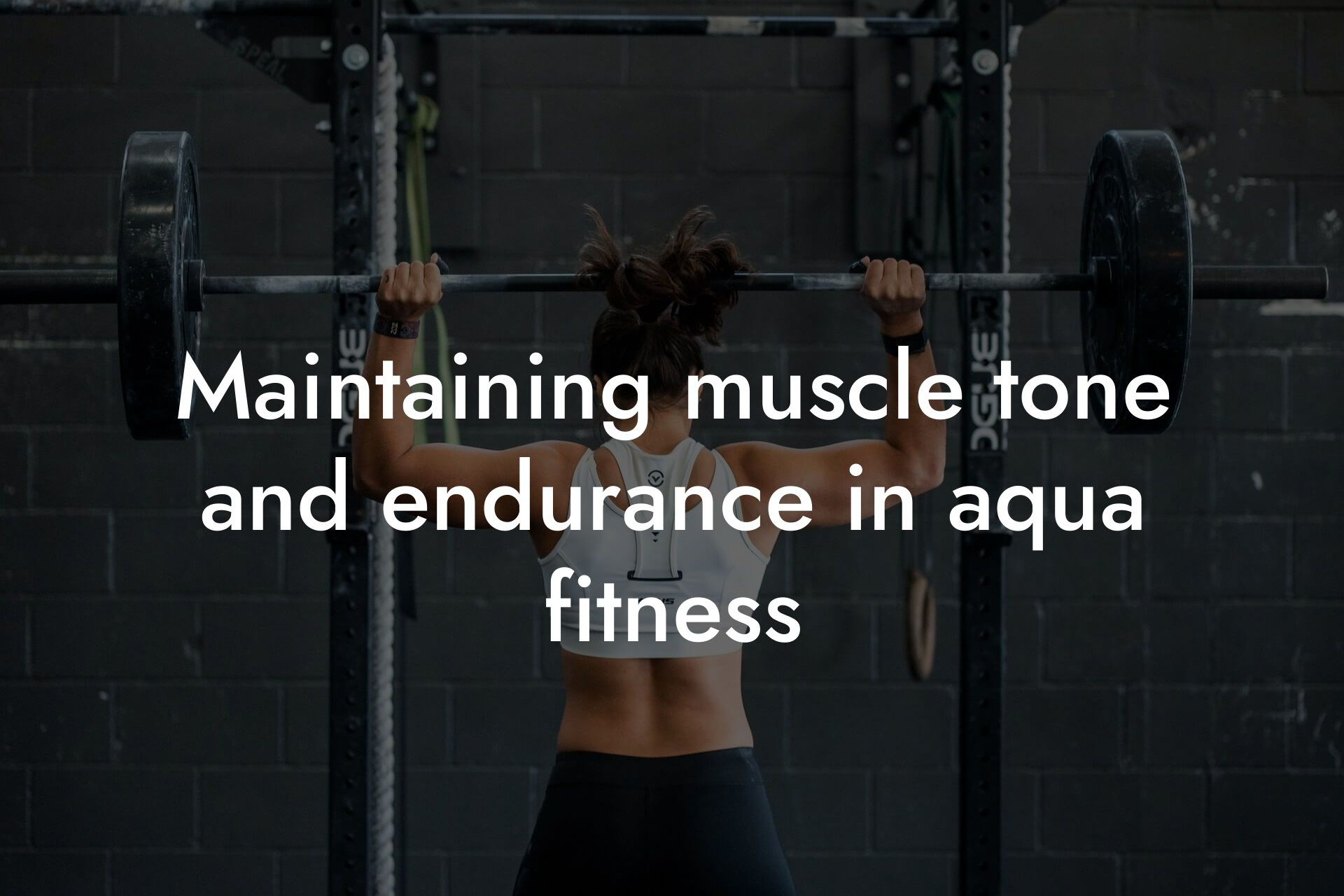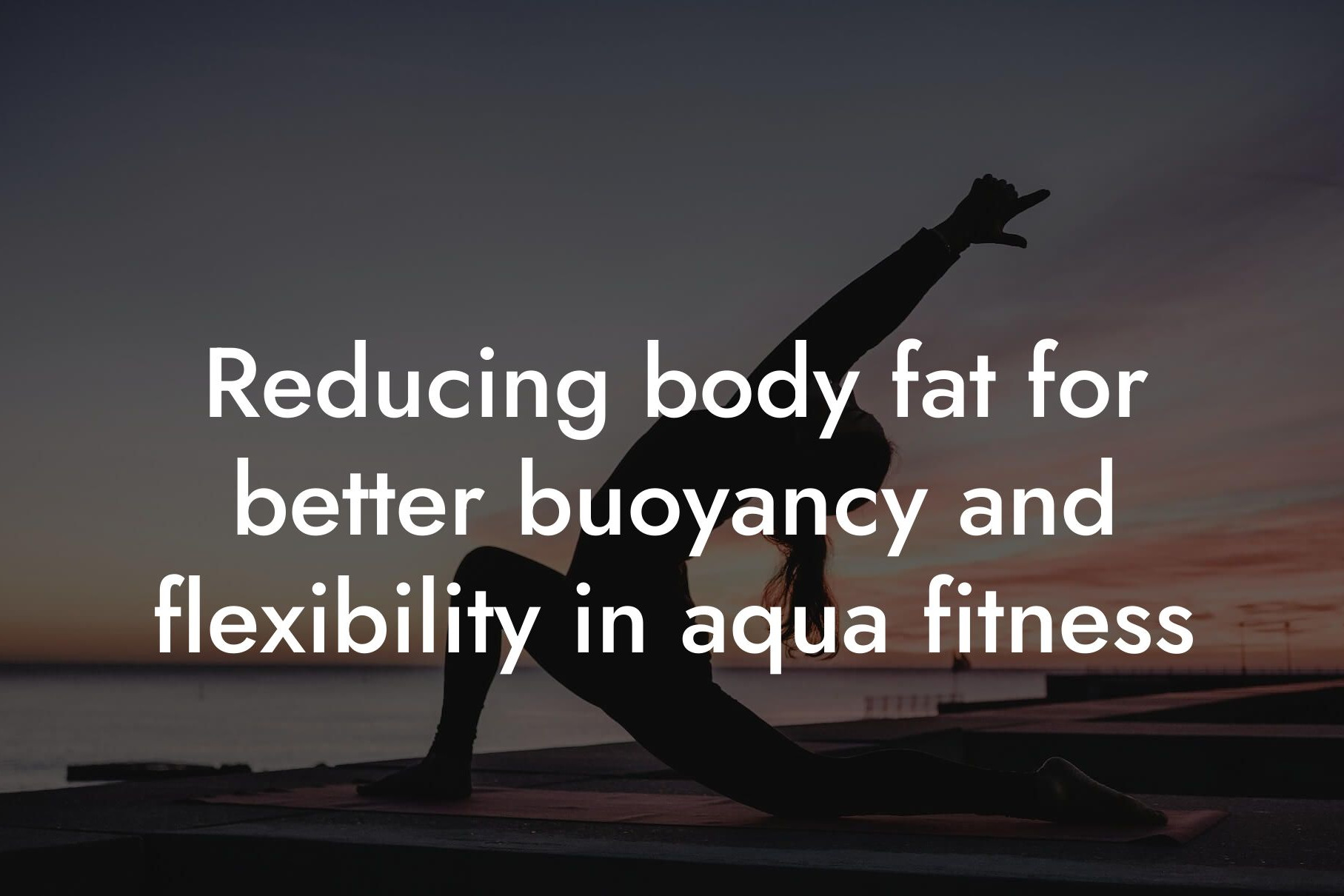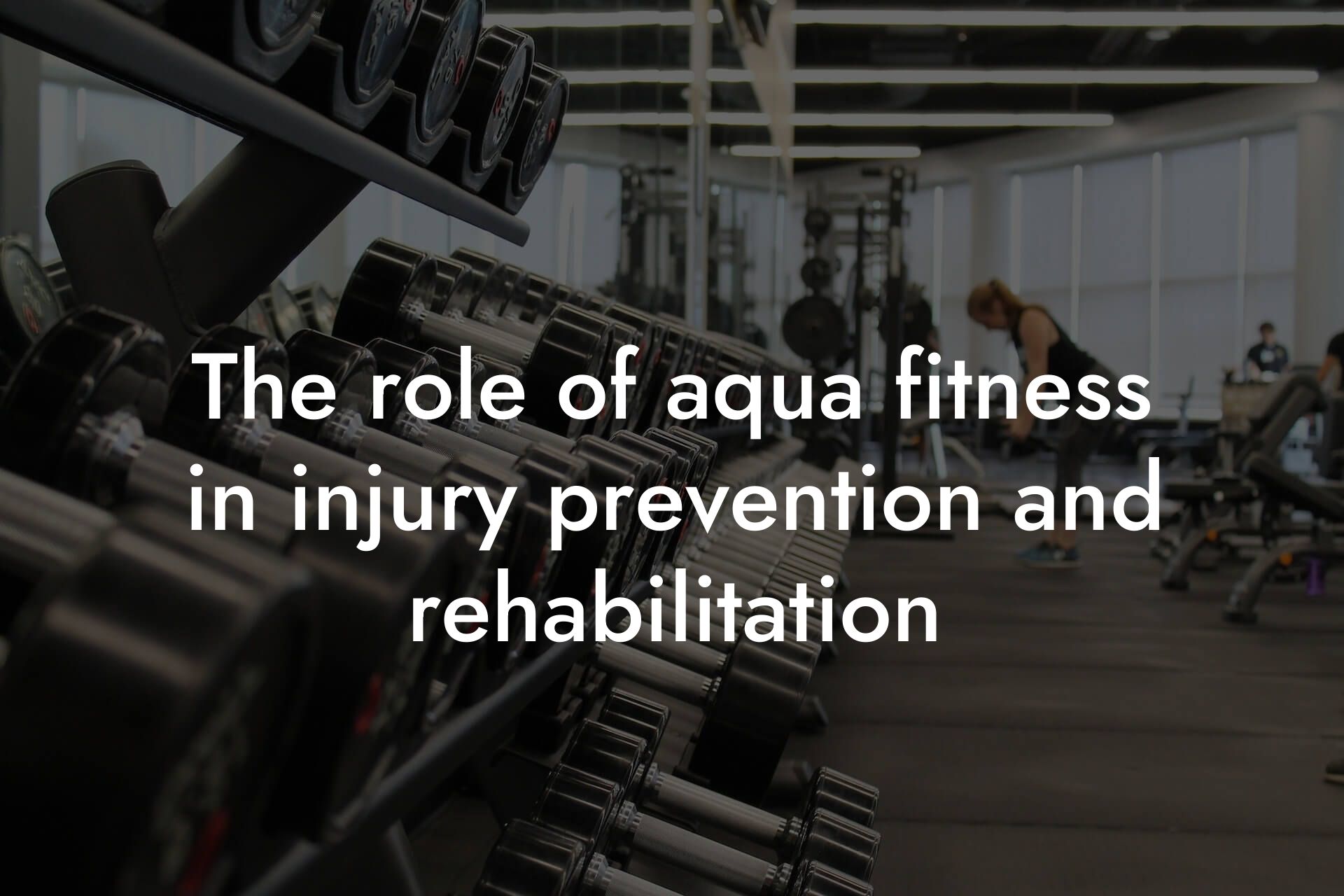As an aqua fitness practitioner, you understand the importance of recovery in maintaining optimal physical performance. Aqua fitness exercises can be high-intensity, and without proper recovery techniques, you may experience fatigue, decreased performance, and increased risk of injury. In this article, we will explore the importance of recovery for aqua fitness practitioners and provide you with a comprehensive guide to recovery techniques that you can incorporate into your routine.
Table of Contents
- Why Recovery is Crucial for Aqua Fitness Practitioners
- Types of Recovery Techniques for Aqua Fitness Practitioners
- Active Recovery Techniques for Aqua Fitness Practitioners
- Passive Recovery Techniques for Aqua Fitness Practitioners
- Restorative Recovery Techniques for Aqua Fitness Practitioners
- Creating a Recovery Plan for Aqua Fitness Practitioners
- Frequently Asked Questions
Why Recovery is Crucial for Aqua Fitness Practitioners
Recovery is a critical component of any exercise program, and aqua fitness is no exception. During exercise, your muscles undergo micro-tears, and your body needs time to repair and rebuild them. Without adequate recovery, you may experience delayed onset muscle soreness (DOMS), fatigue, and decreased performance. Additionally, inadequate recovery can lead to overtraining, which can result in injury, illness, and burnout.
Aqua fitness practitioners, in particular, need to prioritize recovery due to the unique demands of water-based exercise. Water provides resistance in multiple directions, which can cause additional stress on the muscles and joints. Furthermore, the buoyancy of water can mask fatigue, leading to overexertion and increased risk of injury.
Types of Recovery Techniques for Aqua Fitness Practitioners
There are several types of recovery techniques that aqua fitness practitioners can use to aid in the recovery process. These include:
1. Active Recovery: This involves engaging in low-intensity aerobic exercise, such as swimming or cycling, to promote blood flow and aid in the removal of waste products.
2. Passive Recovery: This involves using techniques such as foam rolling, massage, and compression garments to aid in recovery.
3. Restorative Recovery: This involves using techniques such as yoga, Pilates, and meditation to promote relaxation and reduce stress.
Active Recovery Techniques for Aqua Fitness Practitioners
Active recovery techniques are an excellent way to aid in the recovery process while still engaging in physical activity. Some active recovery techniques that aqua fitness practitioners can use include:
1. Easy Swimming: Engage in easy swimming laps at a low intensity to promote blood flow and aid in the removal of waste products.
2. Water Walking: Walk in the water at a low intensity to promote blood flow and aid in the removal of waste products.
3. Cycling: Engage in low-intensity cycling to promote blood flow and aid in the removal of waste products.
Passive Recovery Techniques for Aqua Fitness Practitioners
Passive recovery techniques are an excellent way to aid in the recovery process without engaging in physical activity. Some passive recovery techniques that aqua fitness practitioners can use include:
1. Foam Rolling: Use a foam roller to roll out tight muscles and aid in the removal of waste products.
2. Massage: Receive a massage to aid in the removal of waste products and promote relaxation.
3. Compression Garments: Wear compression garments to aid in the removal of waste products and promote blood flow.
Restorative Recovery Techniques for Aqua Fitness Practitioners
Restorative recovery techniques are an excellent way to aid in the recovery process by promoting relaxation and reducing stress. Some restorative recovery techniques that aqua fitness practitioners can use include:
1. Yoga: Engage in yoga to promote relaxation, flexibility, and balance.
2. Pilates: Engage in Pilates to promote core strength, flexibility, and balance.
3. Meditation: Engage in meditation to promote relaxation and reduce stress.
Creating a Recovery Plan for Aqua Fitness Practitioners
Creating a recovery plan is essential for aqua fitness practitioners to ensure that they are adequately recovering from their workouts. Here are some tips for creating a recovery plan:
1. Identify Your Recovery Needs: Identify your specific recovery needs based on your workout intensity, frequency, and duration.
2. Prioritize Sleep: Prioritize sleep and aim for 7-9 hours of sleep per night to aid in recovery.
3. Incorporate Active Recovery: Incorporate active recovery techniques, such as easy swimming or cycling, into your routine.
4. Incorporate Passive Recovery: Incorporate passive recovery techniques, such as foam rolling or massage, into your routine.
5. Incorporate Restorative Recovery: Incorporate restorative recovery techniques, such as yoga or meditation, into your routine.
In conclusion, recovery is a critical component of any exercise program, and aqua fitness practitioners need to prioritize recovery to maintain optimal physical performance. By incorporating active, passive, and restorative recovery techniques into your routine, you can aid in the recovery process and reduce the risk of injury and overtraining. Remember to create a recovery plan that is tailored to your specific needs and prioritize sleep, nutrition, and hydration to aid in the recovery process.
At Tano Performance Group, we understand the importance of recovery in maintaining optimal physical performance. Our DEXA machine provides a comprehensive body assessment, including body fat percentage, bone density, and muscle mass, to help you optimize your recovery and take your performance to the next level. Contact us today to learn more about our services and how we can help you achieve your fitness goals.
Frequently Asked Questions
What is the importance of recovery techniques for aqua fitness practitioners?
As an aqua fitness practitioner, it's essential to prioritize recovery techniques to maintain optimal physical performance, prevent injuries, and reduce muscle soreness. Recovery techniques help your body adapt to the demands of aquatic exercise, allowing you to perform at your best and achieve your fitness goals.
What are some common signs of overtraining in aqua fitness?
Common signs of overtraining in aqua fitness include fatigue, decreased performance, muscle soreness, joint pain, and decreased motivation. If you're experiencing any of these symptoms, it's crucial to incorporate recovery techniques into your routine to avoid burnout and prevent injuries.
How does aqua fitness differ from traditional land-based exercise?
Aqua fitness offers a unique set of benefits, including reduced impact on joints, increased buoyancy, and improved cardiovascular performance. However, it also presents specific challenges, such as increased resistance and hydrostatic pressure, which require specialized recovery techniques.
What are some common recovery techniques used in aqua fitness?
Common recovery techniques used in aqua fitness include stretching, foam rolling, self-myofascial release, compression garments, and active recovery techniques like gentle swimming or water walking. These techniques help reduce muscle soreness, improve circulation, and promote relaxation.
How often should I incorporate recovery techniques into my aqua fitness routine?
Aim to incorporate recovery techniques into your routine 2-3 times per week, or as needed. This can include post-workout stretching, active recovery sessions, or dedicated recovery days. Listen to your body and adjust your recovery schedule accordingly.
What is the role of nutrition in recovery for aqua fitness practitioners?
Nutrition plays a critical role in recovery for aqua fitness practitioners. Focus on consuming a balanced diet rich in protein, complex carbohydrates, and healthy fats to support muscle repair, replenish energy stores, and promote overall health.
Can I use recovery techniques to improve my overall performance in aqua fitness?
Absolutely! Recovery techniques can help improve your overall performance in aqua fitness by reducing muscle soreness, improving flexibility, and enhancing cardiovascular performance. By incorporating recovery techniques into your routine, you can optimize your performance and achieve your fitness goals.
How does sleep impact recovery for aqua fitness practitioners?
Sleep is essential for recovery in aqua fitness. Aim for 7-9 hours of sleep per night to allow your body to repair and adapt to the demands of aquatic exercise. Poor sleep can impede recovery, leading to decreased performance and increased risk of injury.
What is the role of stress management in recovery for aqua fitness practitioners?
Stress management is critical for recovery in aqua fitness. High levels of stress can impede recovery, leading to decreased performance and increased risk of injury. Engage in stress-reducing activities like meditation, yoga, or deep breathing exercises to promote relaxation and support recovery.
Can I use recovery techniques to prevent injuries in aqua fitness?
Yes! Recovery techniques can help prevent injuries in aqua fitness by reducing muscle imbalances, improving flexibility, and enhancing joint mobility. By incorporating recovery techniques into your routine, you can reduce your risk of injury and maintain optimal physical performance.
How does flexibility impact recovery for aqua fitness practitioners?
Flexibility is essential for recovery in aqua fitness. Regular stretching and flexibility exercises can help improve range of motion, reduce muscle soreness, and promote relaxation. Focus on exercises that target key muscle groups, such as the shoulders, hips, and legs.
What is the role of compression garments in recovery for aqua fitness practitioners?
Compression garments can help improve circulation, reduce muscle soreness, and promote relaxation. Wear compression garments during and after exercise to enhance recovery and support optimal physical performance.
Can I use active recovery techniques to improve my cardiovascular performance in aqua fitness?
Yes! Active recovery techniques like gentle swimming or water walking can help improve cardiovascular performance in aqua fitness. These techniques promote blood flow, reduce muscle soreness, and enhance cardiovascular function.
How does self-myofascial release impact recovery for aqua fitness practitioners?
Self-myofascial release can help reduce muscle soreness, improve flexibility, and promote relaxation. Use tools like foam rollers or lacrosse balls to release tension in key muscle groups, such as the IT band, quadriceps, and hamstrings.
What is the role of protein in recovery for aqua fitness practitioners?
Protein is essential for recovery in aqua fitness. Consume protein-rich foods or supplements within 30-60 minutes after exercise to support muscle repair, replenish energy stores, and promote overall health.
Can I use recovery techniques to improve my body composition in aqua fitness?
Absolutely! Recovery techniques can help improve body composition in aqua fitness by reducing muscle soreness, improving flexibility, and enhancing metabolic function. By incorporating recovery techniques into your routine, you can optimize your body composition and achieve your fitness goals.
How does hydration impact recovery for aqua fitness practitioners?
Hydration is critical for recovery in aqua fitness. Aim to consume at least 8-10 glasses of water per day to replenish fluids, electrolytes, and energy stores. Proper hydration can help reduce muscle soreness, improve performance, and support overall health.
What is the role of electrolytes in recovery for aqua fitness practitioners?
Electrolytes play a critical role in recovery for aqua fitness practitioners. Consume electrolyte-rich foods or supplements to replenish sodium, potassium, and magnesium levels, which can become depleted during exercise.
Can I use recovery techniques to reduce muscle soreness in aqua fitness?
Absolutely! Recovery techniques like stretching, foam rolling, and self-myofascial release can help reduce muscle soreness in aqua fitness. These techniques promote blood flow, reduce inflammation, and promote relaxation.
How does mental recovery impact performance in aqua fitness?
Mental recovery is critical for performance in aqua fitness. Engage in stress-reducing activities, practice mindfulness, and focus on positive self-talk to promote mental recovery and support optimal physical performance.
What is the role of rest days in recovery for aqua fitness practitioners?
Rest days are essential for recovery in aqua fitness. Take regular rest days to allow your body to repair, adapt, and recharge. This can help reduce muscle soreness, improve performance, and support overall health.
Can I use recovery techniques to improve my overall health and wellbeing in aqua fitness?
Absolutely! Recovery techniques can help improve overall health and wellbeing in aqua fitness by reducing muscle soreness, improving flexibility, and promoting relaxation. By incorporating recovery techniques into your routine, you can optimize your overall health and wellbeing.
How does aqua fitness impact bone density?
Aqua fitness can help improve bone density by promoting weight-bearing exercise, reducing impact on joints, and enhancing muscle strength. Regular aquatic exercise can help support bone health and reduce the risk of osteoporosis.
Here are some related articles you might love...
- Maintaining muscle tone and endurance in aqua fitness
- Reducing body fat for better buoyancy and flexibility in aqua fitness
- The role of aqua fitness in injury prevention and rehabilitation
- Using DEXA scans to monitor progress in aqua fitness
- Nutrition tips for sustained energy in aqua fitness classes
- Bone density and its role in aqua fitness performance
- How body composition impacts aqua fitness performance
- Balancing strength, flexibility, and cardiovascular health in aqua fitness
- Strength training tips to complement your aqua fitness routine
Zak Faulkner
Zak Faulkner is a leading authority in the realm of physical health and body composition analysis, with over 15 years of experience helping professionals optimise their fitness and well-being. As one the experts behind Tano Performance Group, Zak has dedicated his career to providing in-depth, science-backed insights that empower clients to elevate their physical performance and overall health.
With extensive knowledge of DEXA technology, Zak specializes in delivering comprehensive body assessments that offer precise data on body fat, muscle mass, bone density, and overall physique. His expertise enables individuals to make informed decisions and achieve their fitness goals with accuracy and confidence. Zak’s approach is rooted in a deep understanding of human physiology, combined with a passion for helping clients unlock their full potential through personalised strategies.
Over the years, Zak has earned a reputation for his commitment to excellence, precision, and client-focused service. His guidance is trusted by top professionals who demand the best when it comes to their health. Whether advising on fitness programs, nutritional strategies, or long-term wellness plans, Zak Faulkner’s insights are a valuable resource for anyone serious about taking their health and fitness to the next level.
At Tano Performance Group, Zak continues to lead our Content Team revolutionising how professionals approach their physical health, offering unparalleled expertise that drives real results.




